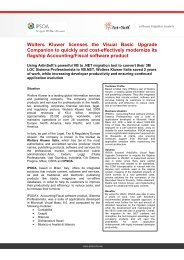Visual Basic Upgrade Companion vs. Code Advisor - ArtinSoft
Visual Basic Upgrade Companion vs. Code Advisor - ArtinSoft
Visual Basic Upgrade Companion vs. Code Advisor - ArtinSoft
Create successful ePaper yourself
Turn your PDF publications into a flip-book with our unique Google optimized e-Paper software.
“vbDefault”. Since both of them share a common underlying value of zero, the same results are<br />
observed at runtime even when the assignment is incorrect.<br />
In <strong>Visual</strong> <strong>Basic</strong> .NET, only the values defined for each property are allowed. However, the <strong>Visual</strong><br />
<strong>Basic</strong> <strong>Upgrade</strong> <strong>Companion</strong> has extended coverage for enumerations, which allow it to recognize<br />
incorrect enumeration values and constants and replace them with the appropriate ones. For<br />
instance, the following VB6 code uses an incorrect enumeration value and the literal “2” to set the<br />
MousePointer property of a form and the Alignment property of a TextBox, respectively.<br />
Me.MousePointer = vbDefault<br />
'FIXIT: The use of 'vbNormal' is not valid for the property…<br />
Me.MousePointer = vbNormal<br />
Me.Text1.AlignMent = vbLeftJustify<br />
Me.Text1.AlignMent = vbCenter<br />
Me.Text1.AlignMent = vbRightJustify<br />
Me.Text1.AlignMent = 2<br />
The <strong>Visual</strong> <strong>Basic</strong> <strong>Upgrade</strong> <strong>Companion</strong> is able to recognize the values being assigned and translate<br />
them to their correct equivalents in .NET:<br />
Me.Cursor = Cursors.Default<br />
'FIXIT: The use of 'vbNormal' is not valid for the property…<br />
Me.Cursor = Cursors.Default<br />
Me.Text1.TextAlign = HorizontalAlignMent.Left<br />
Me.Text1.TextAlign = HorizontalAlignMent.Center<br />
Me.Text1.TextAlign = HorizontalAlignMent.Right<br />
Me.Text1.TextAlign = HorizontalAlignMent.Center<br />
Use Option Explicit to avoid implicitly creating variables of type Variant<br />
Whether it is a good practice to always use Option Explicit in <strong>Visual</strong> <strong>Basic</strong> 6.0, the type inference<br />
capabilities of VBUC can solve most of the late binding and make this revision unnecessary in VB6.<br />
Types that could not be inferred during migration will be marked with the following late binding<br />
<strong>Upgrade</strong> Warning<br />
'UPGRADE_WARNING: Couldn't resolve default property of object <br />
and should be reviewed after migration.<br />
Case Study<br />
To test the effectiveness of the <strong>Visual</strong> <strong>Basic</strong> <strong>Upgrade</strong> <strong>Companion</strong>, three real-world applications were<br />
processed by <strong>Code</strong> <strong>Advisor</strong> and then migrated to .NET by VBUC. Table 1 shows the size of each<br />
application, measured in Effective Lines of <strong>Code</strong>, and the number of FixIts that were added by <strong>Code</strong><br />
<strong>Advisor</strong> to each one. In this context, Effective Lines of <strong>Code</strong> represent all the VB6 lines in classes,



